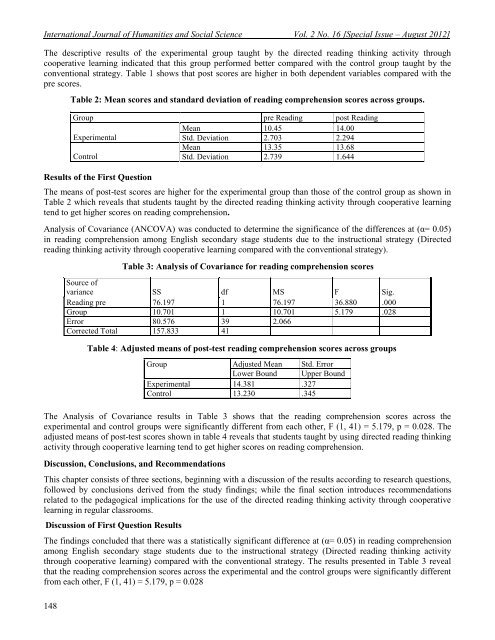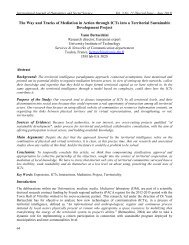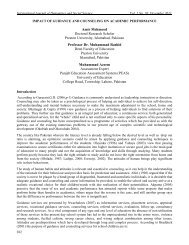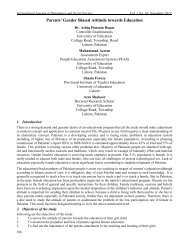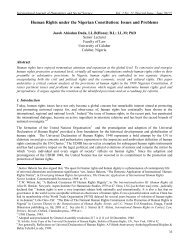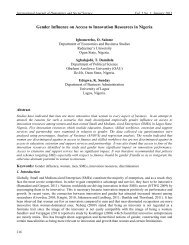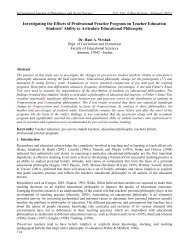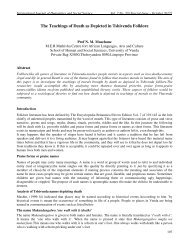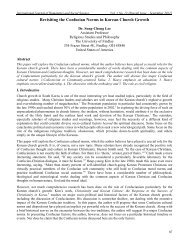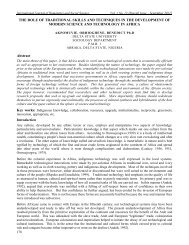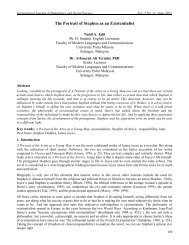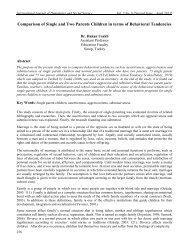The Effect of the Directed Reading Thinking Activity through ...
The Effect of the Directed Reading Thinking Activity through ...
The Effect of the Directed Reading Thinking Activity through ...
You also want an ePaper? Increase the reach of your titles
YUMPU automatically turns print PDFs into web optimized ePapers that Google loves.
International Journal <strong>of</strong> Humanities and Social Science Vol. 2 No. 16 [Special Issue – August 2012]<br />
<strong>The</strong> descriptive results <strong>of</strong> <strong>the</strong> experimental group taught by <strong>the</strong> directed reading thinking activity <strong>through</strong><br />
cooperative learning indicated that this group performed better compared with <strong>the</strong> control group taught by <strong>the</strong><br />
conventional strategy. Table 1 shows that post scores are higher in both dependent variables compared with <strong>the</strong><br />
pre scores.<br />
148<br />
Table 2: Mean scores and standard deviation <strong>of</strong> reading comprehension scores across groups.<br />
Group pre <strong>Reading</strong> post <strong>Reading</strong><br />
Mean 10.45 14.00<br />
Experimental<br />
Std. Deviation 2.703 2.294<br />
Mean 13.35 13.68<br />
Control<br />
Std. Deviation 2.739 1.644<br />
Results <strong>of</strong> <strong>the</strong> First Question<br />
<strong>The</strong> means <strong>of</strong> post-test scores are higher for <strong>the</strong> experimental group than those <strong>of</strong> <strong>the</strong> control group as shown in<br />
Table 2 which reveals that students taught by <strong>the</strong> directed reading thinking activity <strong>through</strong> cooperative learning<br />
tend to get higher scores on reading comprehension.<br />
Analysis <strong>of</strong> Covariance (ANCOVA) was conducted to determine <strong>the</strong> significance <strong>of</strong> <strong>the</strong> differences at (α= 0.05)<br />
in reading comprehension among English secondary stage students due to <strong>the</strong> instructional strategy (<strong>Directed</strong><br />
reading thinking activity <strong>through</strong> cooperative learning compared with <strong>the</strong> conventional strategy).<br />
Table 3: Analysis <strong>of</strong> Covariance for reading comprehension scores<br />
Source <strong>of</strong><br />
variance SS df MS F Sig.<br />
<strong>Reading</strong> pre 76.197 1 76.197 36.880 .000<br />
Group 10.701 1 10.701 5.179 .028<br />
Error 80.576 39 2.066<br />
Corrected Total 157.833 41<br />
Table 4: Adjusted means <strong>of</strong> post-test reading comprehension scores across groups<br />
<strong>The</strong> Analysis <strong>of</strong> Covariance results in Table 3 shows that <strong>the</strong> reading comprehension scores across <strong>the</strong><br />
experimental and control groups were significantly different from each o<strong>the</strong>r, F (1, 41) = 5.179, p = 0.028. <strong>The</strong><br />
adjusted means <strong>of</strong> post-test scores shown in table 4 reveals that students taught by using directed reading thinking<br />
activity <strong>through</strong> cooperative learning tend to get higher scores on reading comprehension.<br />
Discussion, Conclusions, and Recommendations<br />
This chapter consists <strong>of</strong> three sections, beginning with a discussion <strong>of</strong> <strong>the</strong> results according to research questions,<br />
followed by conclusions derived from <strong>the</strong> study findings; while <strong>the</strong> final section introduces recommendations<br />
related to <strong>the</strong> pedagogical implications for <strong>the</strong> use <strong>of</strong> <strong>the</strong> directed reading thinking activity <strong>through</strong> cooperative<br />
learning in regular classrooms.<br />
Discussion <strong>of</strong> First Question Results<br />
Group Adjusted Mean Std. Error<br />
Lower Bound Upper Bound<br />
Experimental 14.381 .327<br />
Control 13.230 .345<br />
<strong>The</strong> findings concluded that <strong>the</strong>re was a statistically significant difference at (α= 0.05) in reading comprehension<br />
among English secondary stage students due to <strong>the</strong> instructional strategy (<strong>Directed</strong> reading thinking activity<br />
<strong>through</strong> cooperative learning) compared with <strong>the</strong> conventional strategy. <strong>The</strong> results presented in Table 3 reveal<br />
that <strong>the</strong> reading comprehension scores across <strong>the</strong> experimental and <strong>the</strong> control groups were significantly different<br />
from each o<strong>the</strong>r, F (1, 41) = 5.179, p = 0.028


